Flexible Binder for S@pPAN Cathode of Lithium Sulfur Battery- Part 2
LI Tingting, ZHANG Yang, CHEN Jiahang, MIN Yulin, WANG Jiulin. Flexible Binder for S@pPAN Cathode of Lithium Sulfur Battery. Journal of Inorganic Materials, 2022, 37(2): 182-188 DOI:10.15541/jim20210303
Physical Properties Characterization
The existing forms of sulfur in the S@pPAN materials were investigated by XRD. In composites, the intercalated sulfur may be tiny particles with a size less than 10 nanometers, even at the molecular level, forming amorphous composites. The characteristic peak at 2θ=25.2° in Figure 1 corresponds to the graphitized crystal plane (002), and there is no sulfur diffraction peak in the composite, which indicates that sulfur is amorphous in S@pPAN.
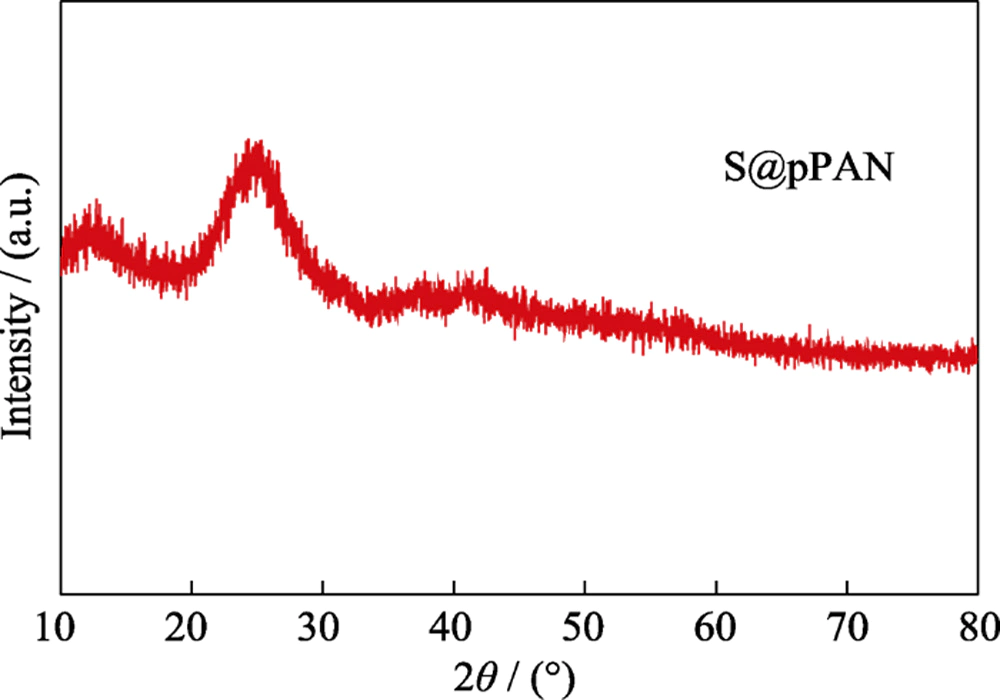
Fig. 1 XRD pattern of S@pPAN
The tensile strength tests were carried out on the SCMC film and the CMC film respectively, and the stress-strain curves are shown in Fig. 2. The enhancement effect of SWCNTs on the mechanical properties of polymer composites mainly depends on the high stress transfer efficiency between SWCNTs and polymer interfaces. Chemical bonds were formed between SWCNT and polymer materials and the interfacial cohesion of the composite material was improved, thereby enhancing the stress transfer capability of the composite material. In this study, the ultimate tensile strength of the SCMC composite film was increased by 41 times. SWCNT also has its own advantages in improving the toughness of composite materials. The integral area of the stress-strain curve corresponds to the fracture toughness of the material, and the integral area of the SCMC film in Figure 2 increases significantly, indicating that its fracture toughness is significantly enhanced. This is due to the bridging mechanism of SWCNTs. During the deformation and fracture process of materials subjected to external forces, SWCNTs in composite materials can effectively connect microcracks and delay crack propagation, playing a toughening role.
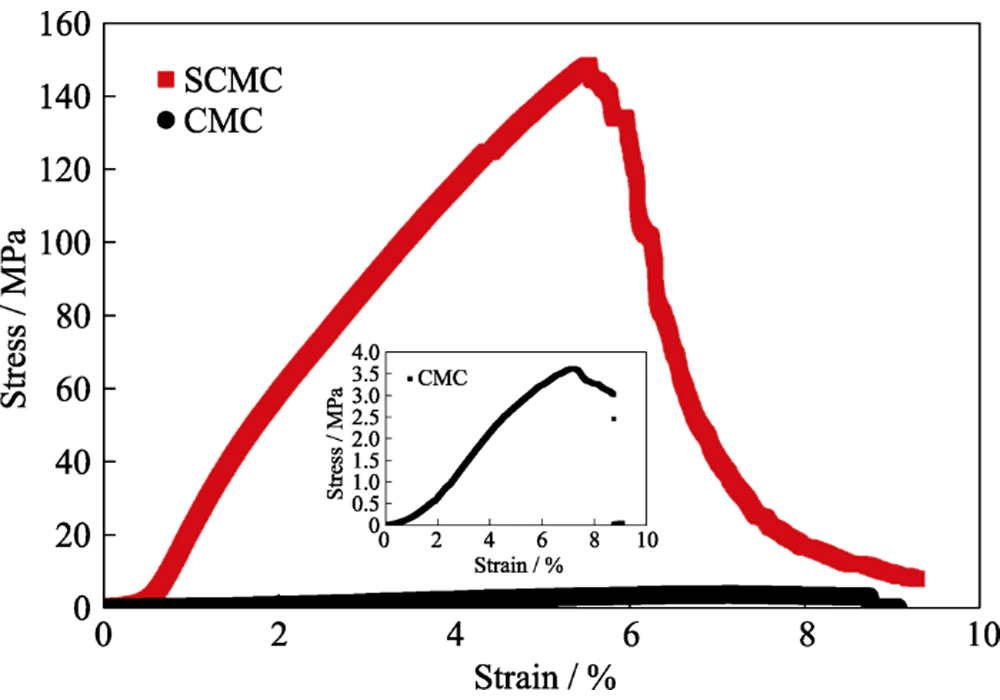
Fig. 2 Stress-strain curves of SCMC and CMC films with inset showing the corresponding magnified curve of CMC film
Electrochemical properties
The cycle performance of the two groups of batteries was tested at a current density of 2C, and the areal density of the positive active material was 0.64 mg cm-2. The results are shown in Figure 3. The discharge specific capacities of the two batteries are very close in the initial 15 cycles, and then the specific capacity of the S@pPAN/CMC|LiPF6|Li battery begins to decline rapidly, while the S@pPAN/SCMC|LiPF6|Li battery can continue to remain stable , the gap between the two discharge specific capacities gradually widened. After 140 cycles, the discharge specific capacity of the S@pPAN/SCMC|LiPF6|Li battery is 1195.4 mAh∙g-1, and the corresponding specific capacity retention rate is 84.7%. However, the specific capacity of S@pPAN/CMC|LiPF6|Li battery is only 1012.1 mAh∙g-1, and the specific capacity retention rate is 71.7%, which is much lower than the former. The cycle performance test results show that the addition of SWCNT can effectively improve the cycle stability of the battery. The reason is that the excellent mechanical properties and excellent conductivity of SWCNT not only improve the interface stability of the electrode but also enhance its electronic conductivity. Compared with other binders in Table 1, the cycle stability of S@pPAN/SCMC|LiPF6|Li battery is outstanding, indicating that SCMC has strong competitiveness in practical lithium-sulfur battery binders.
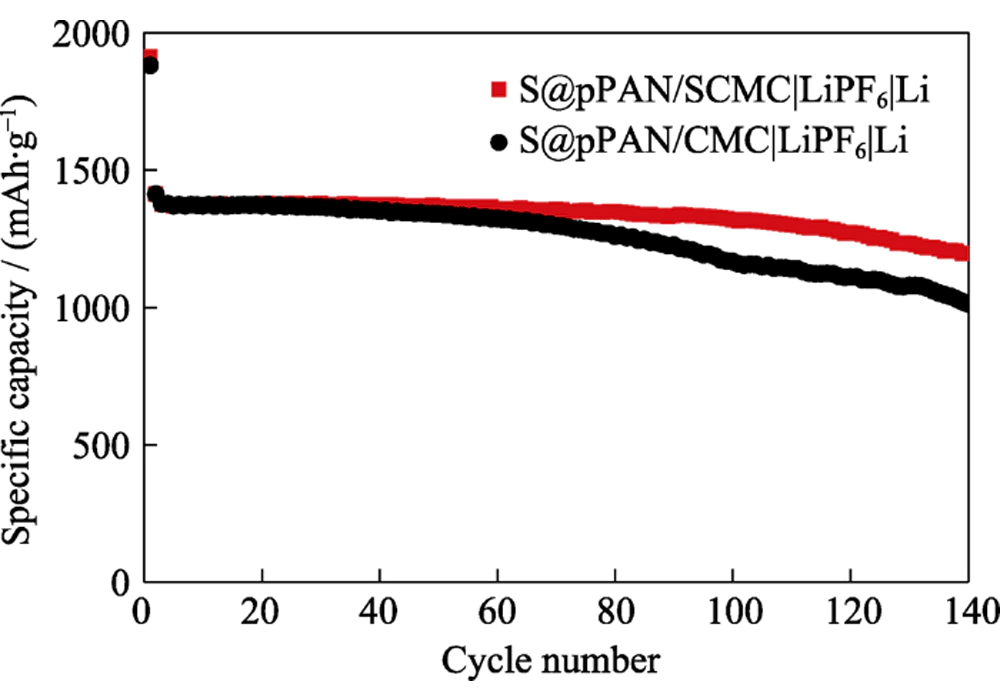
Fig. 3 Cycling performances of S@pPAN/SCMC|LiPF6|Li and S@pPAN/CMC|LiPF6|Li at 2C rate
Table 1 Comparison of the electrochemical performances of sulfur-based cathodes with different binders
|
Binder |
Cathode material |
Active materials :Binder :Conductive agent |
Cyclability/ |
|
GA |
S/C |
8 : 0 : 2 |
1090(50th, 0.2C) |
|
PAA |
S-CPAN |
8 : 1 : 1 |
735(100th, 0.5C) |
|
LA132 |
S-KB |
8 : 1 : 1 |
885(50th, 0.2C) |
|
SBR/CMC |
CNF-S |
7 : 2 : 1 |
586(60th, 0.05C) |
|
C-β-CD |
S@pPAN |
8 : 1 : 1 |
1456(50th, 0.2C) |
|
GG |
S@pPAN |
8 : 1 : 1 |
1375(50th, 0.2C) |
|
This work |
S@pPAN |
8 : 1 : 1 |
1170(147th, 2C) |
The S@pPAN with short-chain sulfur grafted in the conductive ladder structure directly realizes the solid-solid conversion reaction mechanism, avoiding the dissolution and shuttling of polysulfides. In order to verify that the S@pPAN/SCMC electrode does not have polysulfide shuttles during the electrochemical reaction, XPS analysis was performed on the lithium anode of the S@pPAN/SCMC|LiPF6|Li battery after 50 cycles, as shown in Figure 4. The XPS spectrum shows characteristic peaks of elements such as oxygen, fluorine, carbon, and phosphorus, among which fluorine and phosphorus are derived from the residual lithium salt (LiPF6) in the electrolyte, and carbon and oxygen are derived from part of the residual organic solvent. No sulfur-related characteristic peaks were detected on the lithium anode, indicating that there was no dissolution shuttling of polysulfides during the charging and discharging process of the battery.
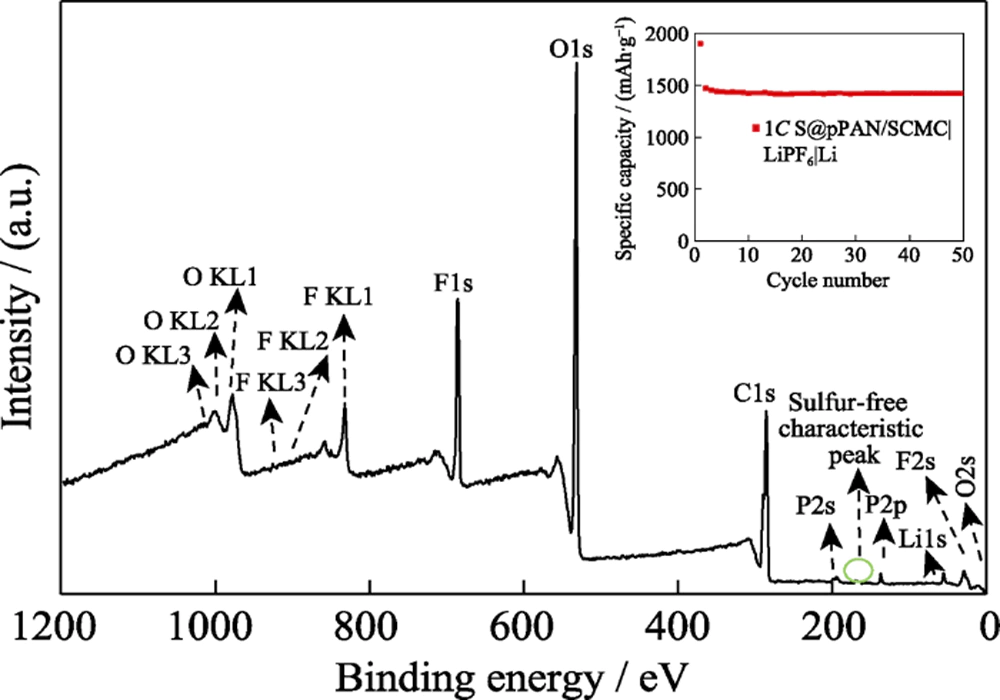
Fig. 4 XPS total spectrum of lithium anode for S@pPAN/ SCMC|LiPF6|Li battery after 50 cycles at 1C rate with inset showing its corresponding cycling performance for 50 cycles
Figure 5(a, b) is the characteristic charge and discharge curves of the two groups of batteries at the 1st, 2nd, 10th, 20th, 50th, 70th and 100th cycle at 2C rate. The discharge platform is an important feature reflecting the internal reaction mechanism of the sulfur cathode. The voltage hysteresis of the S@pPAN composite material is significant in the first discharge cycle, and after the initial cycle, the conductivity of the electrode is improved, leading to a plateau increase in the discharge process. The discharge platforms of S@pPAN/SCMC|LiPF6|Li and S@pPAN/CMC|LiPF6|Li batteries in the second cycle are both 1.72 V, and the charging platforms are around 2.29 V, which is consistent with the literature. The charge-discharge curves of S@pPAN/SCMC|LiPF6|Li battery have a high coincidence degree from the 2nd cycle to the 70th cycle, indicating that the internal polarization of the battery changes little during the cycle, and the electrode/electrolyte interface is very stable. The corresponding S@pPAN/CMC|LiPF6|Li battery charge-discharge curve overlap is low, and the voltage plateau of the charge curve rises significantly. As the number of cycles increases, the internal polarization of the battery increases significantly, resulting in poor cycle stability of the S@pPAN/CMC|LiPF6|Li battery.
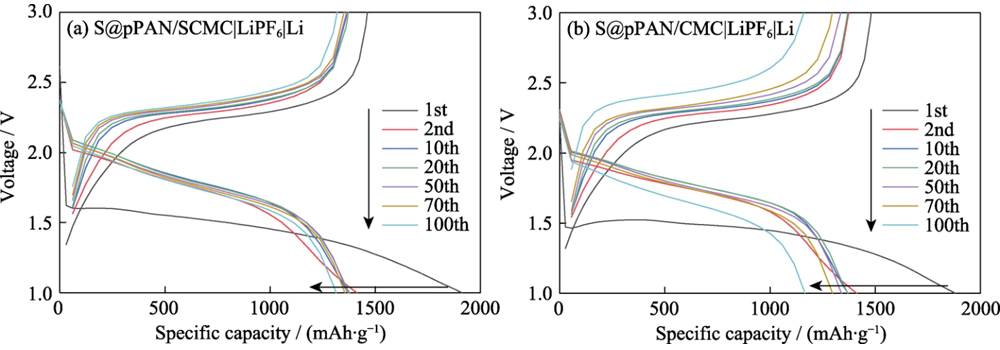
Fig. 5 Chage-discharge curves of (a) S@pPAN/SCMC|LiPF6|Li and (b) S@pPAN/CMC|LiPF6|Li at 2C rate
Figure 6 shows the rate performance test results of two groups of batteries at current densities of 0.5C, 1C, 3C, 5C, 7C, and 0.5C, respectively. There is no significant difference in the discharge specific capacity of the two groups of electrodes when charging and discharging at a low current density. However, as the current density increases, the reversible specific capacity of the S@pPAN/CMC|LiPF6|Li battery is getting lower and lower, and it is only 971.8 mAh∙g-1 at 7C. At this time, the S@pPAN/SCMC|LiPF6|Li battery can still maintain a high specific capacity of 1147 mAh∙g-1, and when the current density returns to 0.5C, the specific capacities of the two groups of batteries are basically restored. The rate performance test results show that the S@pPAN/SCMC|LiPF6|Li battery still has a high specific capacity when it is charged and discharged quickly at a high current, because the addition of SWCNTs improves the bulk electronic conductivity inside the electrode. The electrode sheet forms a conductive network, which can effectively disperse the current density, and the sulfur is in full contact with the conductive framework formed by SWCNT during the cycle, the sulfur conversion kinetics on the electrode surface is significantly improved, and the utilization rate of sulfur is higher.
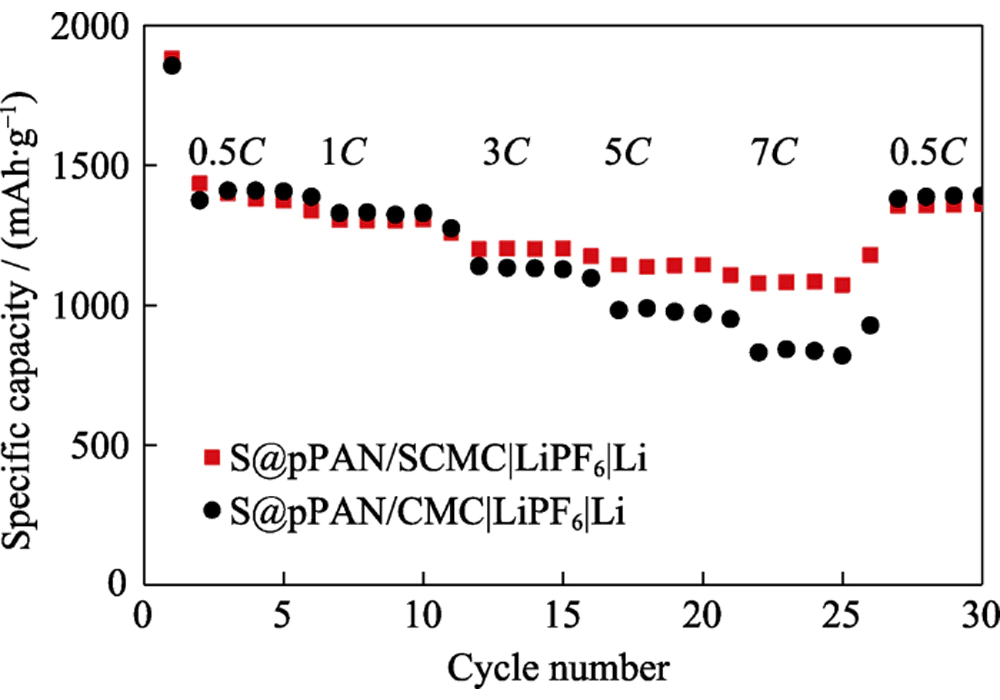
Fig. 6 Rate performance of S@pPAN/SCMC|LiPF6|Li and S@pPAN/CMC|LiPF6|Li
In order to explore the effect of adding SWCNTs on the performance of the sulfur cathode, cyclic voltammetry tests were performed on the two groups of batteries, and the results are shown in Figure 7(a, b). Cyclic voltammetry curves showed that the redox peaks of both groups of batteries did not shift significantly during the first three cycles. However, the peak shape of the S@pPAN/SCMC|LiPF6|Li battery is sharper and the peak current (Ip) is larger, indicating that the electrode reaction kinetics of the battery is better. This is due to the addition of SWCNT to increase the conductivity of the pole piece, which effectively improves the electrochemical performance of the battery.
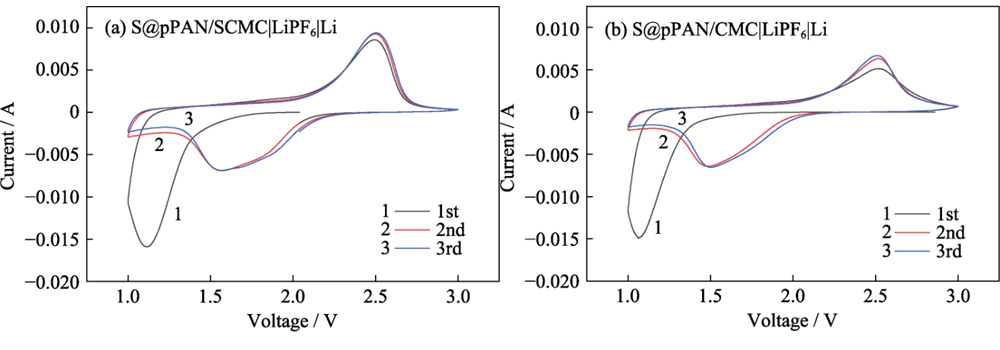
Fig. 7 CV curves of (a) S@pPAN/SCMC|LiPF6|Li and (b) S@pPAN/CMC|LiPF6|Li
In order to further analyze the mechanism of the electrochemical performance of the S@pPAN/SCMC electrode, this study used SEM to observe the surface morphology of the two groups of positive electrode pieces after 100 cycles. It can be seen from Figure 8(a, c) that there are a large number of cracks on the surface of the S@pPAN/CMC positive electrode in the two groups of batteries, and even visible powdering phenomenon. However, the structure of the S@pPAN/SCMC cathode remained intact, and no obvious cracks appeared on the surface. The spherical S@pPAN can be seen at the yellow arrows in Fig. 8(b, d). It is worth noting that in Figure 8(b), it can be seen that SWCNTs can effectively cover the surface of active material particles and build a high-speed electron conduction channel for the entire electrode. And the electrode can maintain structural integrity during electrochemical cycling, which proves that SWCNT can alleviate the volume change during charge and discharge and improve the mechanical stability of the electrode.
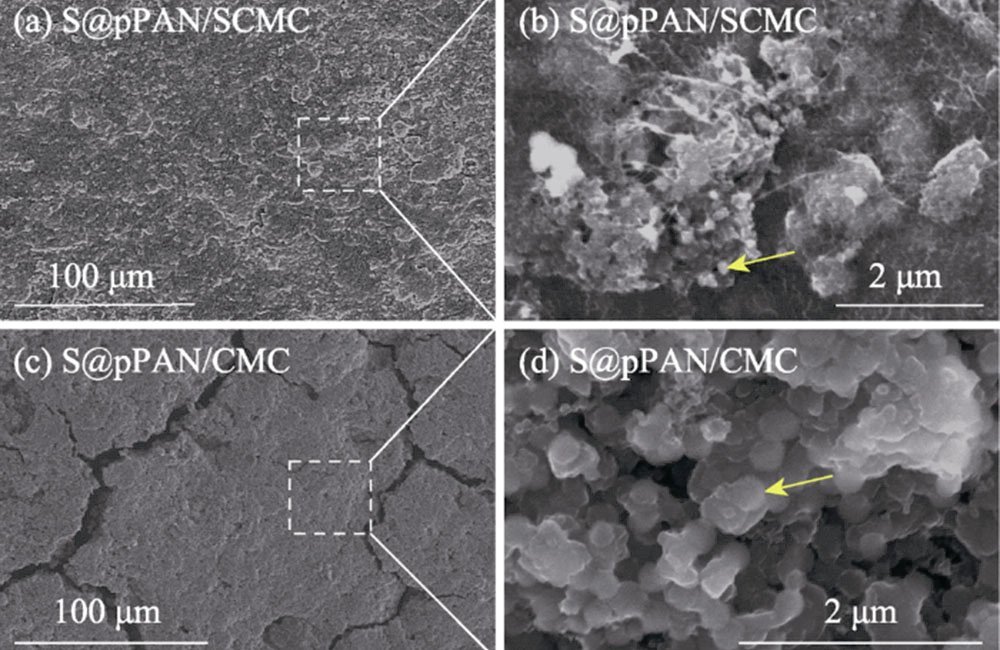
Fig. 8 SEM images of surface morphologies of (a, b) S@pPAN/ SCMC and (c, d) S@pPAN/CMC electrodes after 100 cycles
Failure analysis
In order to verify the failure mechanism of the battery, the battery was reassembled with the cycled positive electrode in this study, and the negative electrode, separator, and electrolyte were replaced. It is worth noting that after 118 cycles of the S@pPAN/CMC|LiPF6|Li battery, the positive electrode structure collapsed and even fell off from the current collector, which can be further confirmed by SEM. The structurally collapsed S@pPAN/CMC cathode sheet cannot be assembled into a button battery with new lithium sheets and electrolyte. The capacity of the S@pPAN/SCMC|LiPF6|Li battery assembled for the first time dropped suddenly after 105 cycles at a current density of 1C (the specific capacity was 1286.4 mAh∙g-1), and the results are shown in Figure 9. After 122 cycles, the electrolyte and lithium sheet were replaced, and the button battery was reassembled, in which the type and amount of electrolyte added were consistent with the first assembled battery. The reassembled S@pPAN/SCMC|LiPF6|Li battery continued to undergo charge and discharge tests under the same test conditions. The test results show that the specific capacity of the reassembled battery can reach 1282.6 mAh∙g-1 after 18 cycles, and the specific capacity recovers to 91.3% (based on the specific capacity of the second cycle discharge of 1405.1 mAh∙g-1). This confirms that the battery capacity loss is mainly attributed to the poor stability of the anode, dendrites and interfacial reactions leading to electrolyte consumption and internal impedance increase.
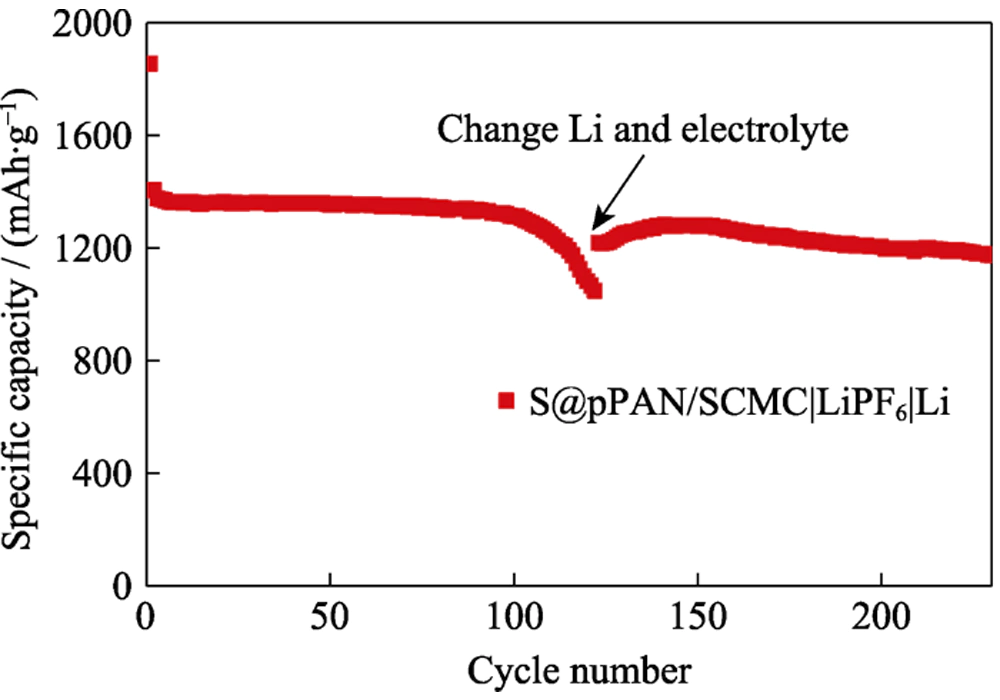
Fig. 9 Cycling performance of S@pPAN/SCMC|LiPF6|Li at 1C rate before and after reassembling
Conclusion
In this study, a new type of three-dimensional network adhesive was designed. By adding SWCNT, the toughness of the adhesive increased significantly, and the ultimate tensile strength increased to 41 times that of the unmodified sample. The S@pPAN/SCMC|LiPF6|Li battery can be stably cycled for 140 cycles at a current density of 2C, the specific capacity retention rate of the battery is 84.7%, and a high specific capacity of 1147 mAh∙g-1 can still be maintained at a high current density of 7C , and there is no crack in the electrode after cycling, indicating that the combination of CMC and SWCNT can not only improve the bonding effect, but also accelerate the reaction kinetics during the charge and discharge process, and effectively alleviate the volume change of the S@pPAN positive electrode. The binder modification method in this study is simple and environmentally friendly, and can be applied not only to lithium-sulfur battery cathodes with high loading capacity and high compaction density, but also to other secondary battery systems that are suitable for water-based binders.
More Lithium ion Battery Materials from TOB New Energy